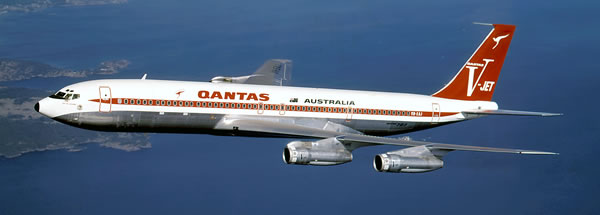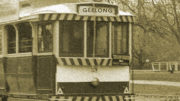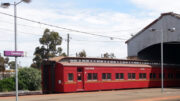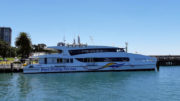There have been several aircraft, marine craft and locomotives named in honour of Geelong, many of which have a rich and colourful history.

Qantas’s Boeing 707 – City of Geelong
Qantas’s City of Geelong was a Boeing 707-338C and carried the registration of VH-EAJ. The jetliner rolled of the Boeing production line in Renton just south of Seattle in Washington State USA in August of 1969. The delivery flight stopped in London where it was chartered to Sydney as a migrant charter. The jet touched down on Australian soil for the first time in Sydney on the 3rd of October 1969.
The jet was nearly lost as part of the horrific Lara bushfires of January 1969, where fire threatened Avalon Airport. Fortunately quick action by the aircrew and engineers moved the jet out of the fire’s path.
The plane was the first Qantas jetliner to operate the Melbourne to Christchurch route, that began in July of 1972.
In May 1975 VH-EAJ was renamed from City of Geelong to City of Broken Hill and flew for Qantas until March of 1976. It was then sold to British Caledonian Airlines and renamed County of Fife. In the late 1970’s it served time in Africa with Nigerian Airlines and later Uganda Airlines.
The plane suffered severe damage in a heavy landing in Brussels in February of 1982 before returning to service only five days later. In the later 1980’s the plane was re-badged Ethiopian Airlines and later Uganda Airlines. The Jet was destroyed in a crash as it tried to land in fog at Rome’s Fiumicino Airport in October of 1988 on a flight from London’s Gatwick Airport. 66 of the 94 people on board did not survive the crash that happened some 1300 metres short of the runway.
Qantas’s Boeing 747 – City of Geelong
Geelong had a brand new 747 Jumbo Jet named in her honour in 1975. VH-EBJ was a 747-238B aircraft and rolled off the Boeing assembly line in April of 1975. Its first passenger flight was from San Francisco to Sydney on May 31st 1975, stopping at Honolulu and Nadi on the route.
The jetliner was leased to Air New Zealand for a short period in October of 1986 before returning to QANTAS service flying between Sydney, Perth and Singapore. In February of 1989 the jet was sold to Allco Aerospace and leased back to Qantas before being re-badged as Air Pacific, a brand partly owned by Qantas.
In 1991 it was sold and transferred around several investment companies in the USA before entering service for United Airlines in June of 1991. December of 2000 saw the plane move to Arizona for storage before being flown to Gander in Ireland in January of 2003. The jumbo then went into service with Ariana Afghan Airlines for the remainder of 2003 until being leased to Libyan Arab Airlines. In 2004 it was registered onto the Armenian Aircraft Register before being flown by IRS Airlines of Nigeria and later leased to Air Van Airlines of Armenia. It was later put into storage in Jakarta before being painted in Grand Comoros colours, an island off Africa. The jetliner was leased to Iran Air in August of 2007 and was eventually sold for scrap in 2015.
Qantas’s Boeing 737 – Geelong
The 737-838 Boeing rolled of the Washington State production line in June of 2008 and arrived into Melbourne’s Tullamarine Airport in July of 2008, flying from Seattle, via Honolulu and Nadi. The plane is registered VH-VZD and was christened Geelong.
In 2012 the plane was decorated with African animals as part of Qantas’s Frequent Flyer program promotion with communications carrier Optus.
The jet currently has three rows of business class making for 12 passengers and 156 economy class seats in a three, three configuration.
HMAT A2 Geelong
The first ship to be named Geelong was a passenger liner that was completed in 1904, for most of the ships’ life it sailed backwards and forwards from Britain to Australia ferrying new Australian emigrants to our land. In August 1914 the Geelong and many others like her were requisitioned for World War One. The ship was converted from a 540 passenger liner to a 1600-person troop ship that was now known as HMAT A2 Geelong. Her time as a troop ship was short-lived as she sunk in the Mediterranean after colliding with another ship in January 1916. At the time of her sinking HMAT A2 Geelong was carrying cargo to London from Sydney.
HMAS Geelong (J201)
The HMAS Geelong was one of 60 Bathurst class corvettes that were built for World War II service. The vessel was built at the Naval Dockyard in Williamstown and launched by the wife of the then Governor of Victoria Lord Winston Dugan on the 22nd April 1941.
The vessel began its service as a minesweeper and anti-submarine patrol ship up the east coast of Australia before being sent to New Caledonia in March of 1942 to do similar tasks before returning to Australian waters and serving time convoying ships between Sydney and Brisbane.
The HMAS Geelong received a refit in 1944 and was assigned to the waters around New Guinea and served as an escort for ships passing through the Sought west pacific area and anti-submarine sweeper.
On October 18th 1944 HMAS Geelong collided with the York an American tanker and sank off the coast of New Guinea north of Landemark, fortunately no lives were lost.
HMAS received two battle honours for her wartime service, one for the Pacific campaign of 1942-44 and the second for New Guinea Service in 1944.
HMAS Geelong (FCPB 215)
The second HMAS Geelong was launched in April 1984 after being built in Cairns, North Queensland. With the Motto “Strive to Succeed” the Freemantle class patrol boat served the Royal Australian Navy until July 2006 when it was decommissioned at HMAS Coonawarra in Darwin. The HMAS Geelong was part of a fleet of 14 similar ships.
The vessel had a length of 41.9 metres and a beam of 7.79 metres and was propelled by 2 MTU series 538 diesel engines and could reach a speed of 30 knots.
HMAS Geelong was primary used for border security protecting or fishing areas, immigration control and drug law enforcement.
Geelong Star
Originally a 1983 built Dutch ship known as the Dirk Dirk, the Geelong Star is a fishing trawler that was based in the Geelong Port from 2015 to 2016. The star received a lot of media attention at the time due to protests about its fishing operations.
Operated by Seafish Tasmania, the 95-metre factory trawler had permission to catch 16,500 tonnes of jack mackerel, red bait and blue mackerel each year. The problem with this type of fishing is that it is very hard to avoid catching dolphins and seals in the process, and it is inevitable that a few of these magnificent creatures get killed.
While the Geelong Star’s operations had been suspended from time to time following incidents where albatross, dolphins and seals have been harmed, fishing operations soon kick back into action after the operators agree to additional mitigation measure imposed by authorities. Eventually after several calls from protesters and MPs to permanently ban the Geelong Star from fishing our waters, the operators of the ship gave up on Australian operations and the ship returned to European waters under her original name.
V/line N464 Locomotive – City of Geelong
The City of Geelong locomotive is a V/Line passenger train that went into service on the 29th of September 1986.
Originally painted tangerine orange and grey, the locomotive now wears the V/Line red, grey and yellow colours. The diesel electric locomotive is one of 25 produced in Somerton, a suburb of Melbourne. The locomotive is 20.03 metres long and has a weight of 123 tonnes. Its massive engines can produce 2476 horsepower and run at a maximum speed of 130 kph.
The locomotive works between regional centres of Victoria and Melbourne, complementing the more modern Bombardier VLocity services throughout the state.
Thanks to the Qantas Heritage Collection for allowing us to use the image above of Boeing 707-338 VH-EAJ taken during a pre-delivery flight near Seattle, USA in 1968.




